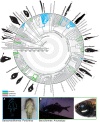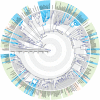Repeated and Widespread Evolution of Bioluminescence in Marine Fishes
- PMID: 27276229
- PMCID: PMC4898709
- DOI: 10.1371/journal.pone.0155154
Repeated and Widespread Evolution of Bioluminescence in Marine Fishes
Abstract
Bioluminescence is primarily a marine phenomenon with 80% of metazoan bioluminescent genera occurring in the world's oceans. Here we show that bioluminescence has evolved repeatedly and is phylogenetically widespread across ray-finned fishes. We recover 27 independent evolutionary events of bioluminescence, all among marine fish lineages. This finding indicates that bioluminescence has evolved many more times than previously hypothesized across fishes and the tree of life. Our exploration of the macroevolutionary patterns of bioluminescent lineages indicates that the present day diversity of some inshore and deep-sea bioluminescent fish lineages that use bioluminescence for communication, feeding, and reproduction exhibit exceptional species richness given clade age. We show that exceptional species richness occurs particularly in deep-sea fishes with intrinsic bioluminescent systems and both shallow water and deep-sea lineages with luminescent systems used for communication.
Conflict of interest statement
Figures




References
-
- Herring PJ (1987) Systematic distribution of bioluminescence in living organisms. J Biolumin Chemilumin 1: 147–163. - PubMed
-
- Haddock SHD, Moline MA, Case JF (2010) Bioluminescence in the sea. Annu Rev Mar Sci 2: 443–493. - PubMed
-
- Kronstrom J, Mallefet J (2010) Evidence for widespread involvement of NO in control of photogenesis in bioluminescent fish. Acta Zool 91: 474–483.
MeSH terms
LinkOut - more resources
Full Text Sources
Other Literature Sources

